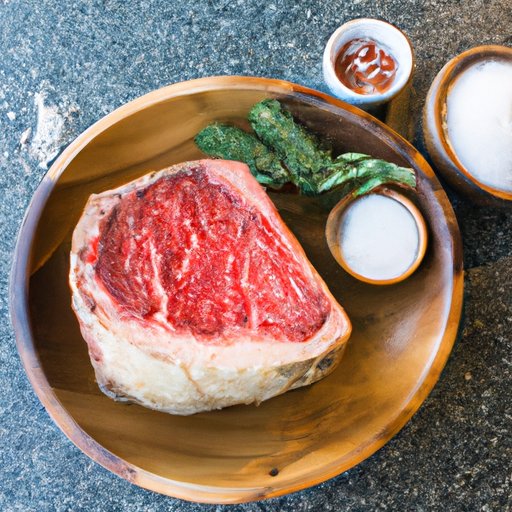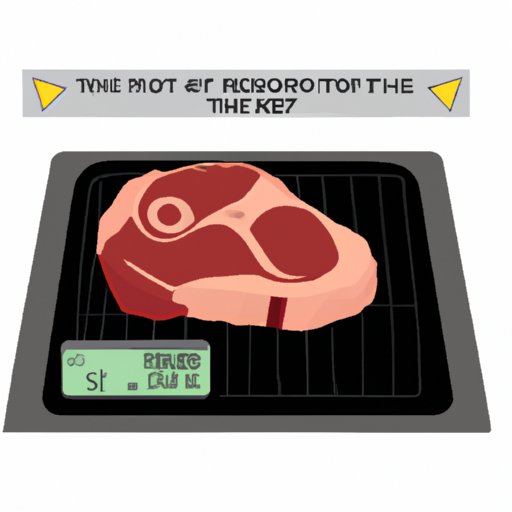
Introduction
There is something special about a perfectly cooked ribeye roast that makes it the star of any special occasion. Juicy and flavorful, it’s hard to resist the mouthwatering aroma that fills the house as it cooks. But cooking a ribeye roast can be intimidating, especially if you’ve never prepared one before. In this article, we’ll provide you with all the information you need to cook a restaurant-quality ribeye roast right at home. From selecting the right cut of meat to presenting it beautifully on the platter, we have you covered.
From Choice to Prime: How to Select the Best Ribeye Roast
Selecting the right ribeye roast is crucial for achieving a delicious outcome. Here are some tips to ensure you’re picking a high-quality cut:
- Know your grades: The USDA grades beef as prime, choice, select, standard, commercial, utility, cutter, and canner. Prime is the highest grade, followed by choice, select, and so on. For the best flavor and tenderness, opt for prime or choice.
- Look for marbling: Marbling refers to the small flecks of fat within the meat. More marbling means more flavor and tenderness. A ribeye roast with a lot of marbling is generally a good sign.
- Check the age: The longer the meat has been aged, the better the flavor and tenderness. Look for a ribeye roast that has been aged for at least 21 days.
The Perfect Ribeye Roast: A Step-by-Step Guide
Once you’ve selected the right ribeye roast, it’s time to start preparing it. Here are the steps you should follow:
- Trim the fat: Remove any excess fat or silver skin from the ribeye roast. Leave a thin layer of fat on top to ensure juiciness.
- Tie the roast: Use kitchen twine to tie the roast in multiple places to ensure even cooking.
- Season the meat: Rub the roast with your preferred seasoning or marinade. We recommend using a simple dry rub of salt, black pepper, and garlic powder for a classic flavor.
- Cook the Ribeye Roast: Preheat the oven to 350°F (175°C), and place the roast in a roasting pan, bone-side down. Cook for about 15-20 minutes per pound for medium-rare. Use a meat thermometer to check for doneness. When the temperature reaches 130°F (54°C), it’s medium-rare, and at 140°F (60°C), it’s medium.
Great Flavors Without Flaws: Tips for Seasoning Your Ribeye Roast
Seasoning can make or break a ribeye roast, so here are some tips to help you make the most of your chosen flavors:
- Keep it simple: For a classic flavor, a blend of salt, black pepper, and garlic powder is all you need.
- Marinate for flavor: A marinade can help tenderize the meat and add extra flavor. A simple red wine and herb marinade is always a solid choice.
- Seasoning the roast: Rub the seasoning all over the roast, making sure it’s evenly distributed. If you’re using a wet marinade, make sure to pat the roast dry before seasoning.

The Right Temperature and Timing: A Foolproof Method for Cooking a Ribeye Roast
To ensure your ribeye roast is cooked to perfection, use these tips:
- Use a meat thermometer: The best way to ensure a perfectly cooked roast is to use a meat thermometer. Insert it into the thickest part of the roast, avoiding the bone. Take the roast out of the oven when it reaches the desired temperature.
- Adjust the timing for size: Cooking times will vary depending on the size of the roast. As a general rule, a 4- to 5-pound roast takes around 1.5 to 2 hours to cook.
- Let it rest: It’s crucial to let the roast rest for at least 15 minutes before carving. This allows the juices to redistribute and ensures maximum flavor. Cover it with foil to keep it warm while resting.
A Guide to Rich and Juicy Gravy for Your Ribeye Roast
A delicious gravy is the perfect accompaniment to a ribeye roast. Here’s how to make it:
- Collect the drippings: Remove the roast from the roasting pan and pour the drippings through a strainer into a saucepan.
- Create the roux: Add flour to the drippings in the saucepan and cook over medium heat for several minutes, stirring constantly until the mixture turns light brown.
- Add the liquid: Slowly pour beef broth into the pan, whisking constantly to avoid any lumps forming. Simmer until thickened, stirring occasionally.
- Season to your taste: Add salt, black pepper, and any other desired herbs to the gravy and stir well. Serve hot with the ribeye roast.
A Twist on Tradition: Delicious Sides to Serve with Your Ribeye Roast
Pairing sides with a ribeye roast is always a personal choice, but here are some suggestions for adding a unique twist:
- Creamy scalloped potatoes: This classic side dish is guaranteed to be a crowd-pleaser. Thinly-sliced potatoes are cooked in a creamy sauce and baked until golden brown.
- Roasted root vegetables: Roast a mixture of carrots, parsnips, and turnips in the oven alongside the ribeye roast for a healthy and flavorful side dish.
- Maple-bacon Brussels sprouts: Cut Brussels sprouts in half, toss with bacon bits and a drizzle of maple syrup, and roast in the oven until tender. The perfect mix of sweet and savory.
Saving the Best for Last: Tips for a Stunning Presentation of Your Ribeye Roast
Presenting a ribeye roast is the final touch that can take a meal from good to great. Consider these tips to make sure your presentation is on point:
- Carve with care: Using a sharp knife, carve the roast into thin slices against the grain. Lay the slices nicely on a platter.
- Add garnish: Fresh herbs, such as rosemary or parsley, add color and a delicious aroma to the plate.
- Get creative: Arrange side dishes in a visually appealing way on the platter with the ribeye roast, playing with colors and shapes to create a feast for the eyes.
Conclusion
Cooking the perfect ribeye roast may seem overwhelming at first, but by following these guidelines, it is easily achievable. Remember to start with a high-quality cut, season and cook it correctly, and don’t forget presentation. With a little bit of patience and care, your ribeye roast will impress your guests and make for a memorable meal.




